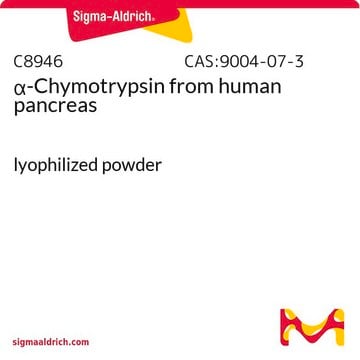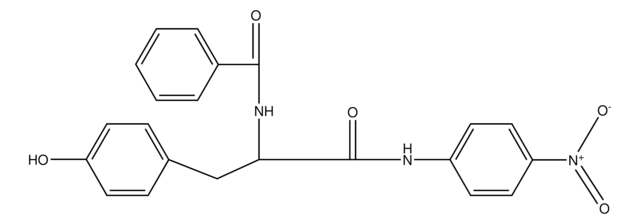C4129
α-Chymotrypsin from bovine pancreas
Type II, lyophilized powder, ≥40 units/mg protein
Synonym(s):
α-chymotrypsin A and B, alpha-chymotrypsin
About This Item
Recommended Products
type
Type II
form
lyophilized powder
specific activity
≥40 units/mg protein
mol wt
25 kDa
composition
protein, ≥85%
color
white to off-white
UniProt accession no.
application(s)
diagnostic assay manufacturing
storage temp.
−20°C
Gene Information
cow ... CTRB1(618826)
Looking for similar products? Visit Product Comparison Guide
Related Categories
Application
Biochem/physiol Actions
Unit Definition
Preparation Note
Analysis Note
Other Notes
Application
inhibitor
substrate
Signal Word
Danger
Hazard Statements
Precautionary Statements
Hazard Classifications
Acute Tox. 4 Oral - Aquatic Acute 1 - Eye Irrit. 2 - Resp. Sens. 1 - Skin Irrit. 2 - STOT SE 3
Target Organs
Respiratory system
Storage Class Code
11 - Combustible Solids
WGK
WGK 1
Personal Protective Equipment
Certificates of Analysis (COA)
Search for Certificates of Analysis (COA) by entering the products Lot/Batch Number. Lot and Batch Numbers can be found on a product’s label following the words ‘Lot’ or ‘Batch’.
Already Own This Product?
Find documentation for the products that you have recently purchased in the Document Library.
Customers Also Viewed
Articles
Analytical Enzyme Chymotrypsin: Chymotrypsin is produced in the acinar cells of the pancreas as the inactive precursor, chymotrypsinogen.
Protocols
Follow our procedure for the determination of a chymotrypsin activity. This enzymatic assay of alpha chymotrypsin guides you through the entire process and necessary calculations.
Chromatograms
application for HPLCOur team of scientists has experience in all areas of research including Life Science, Material Science, Chemical Synthesis, Chromatography, Analytical and many others.
Contact Technical Service













